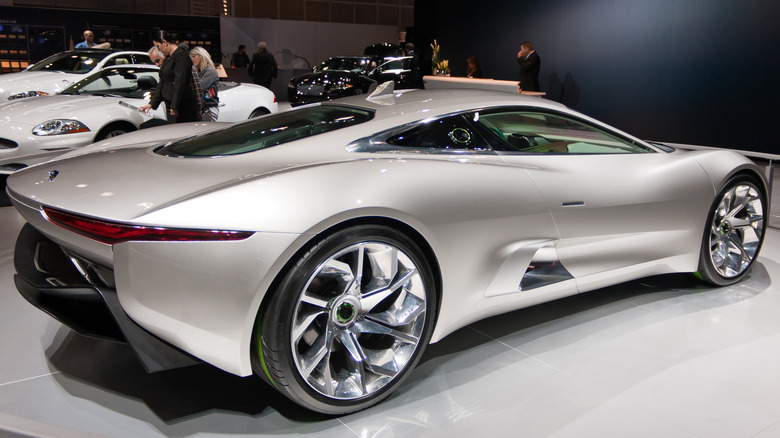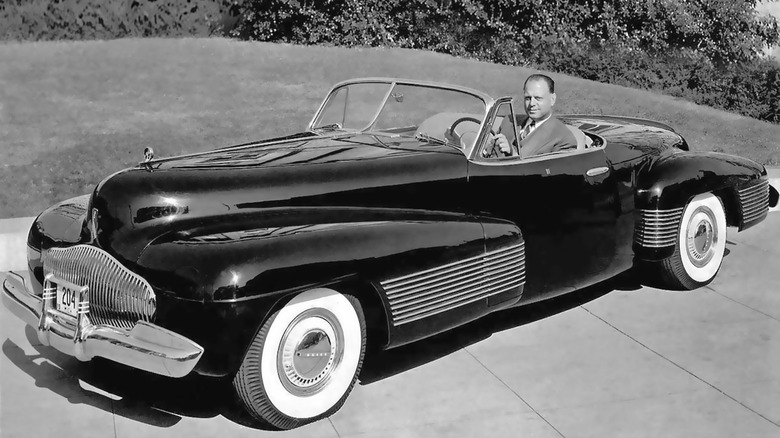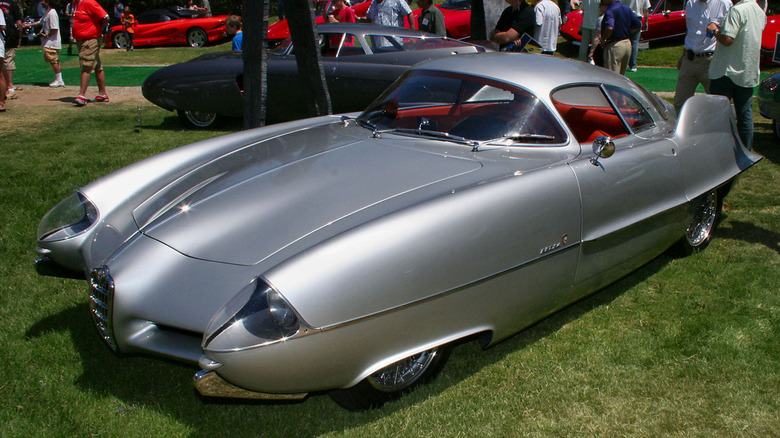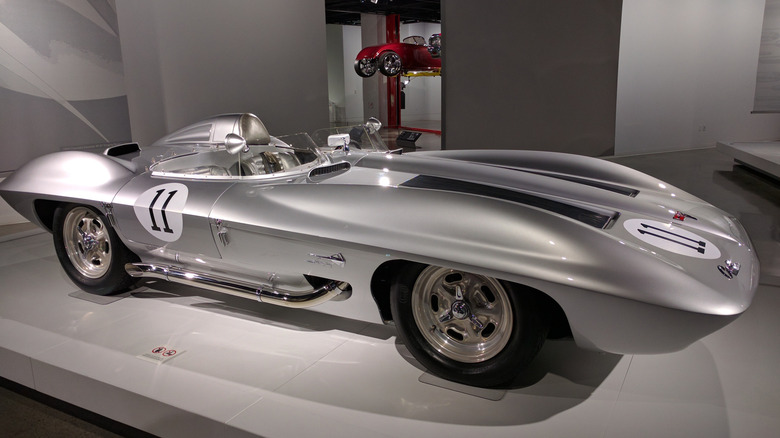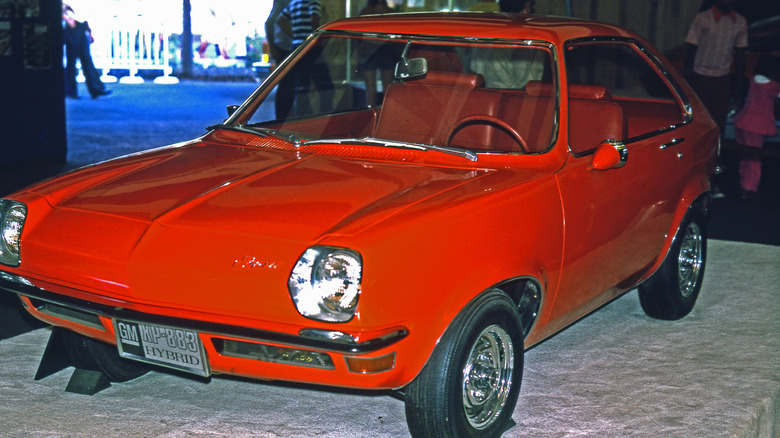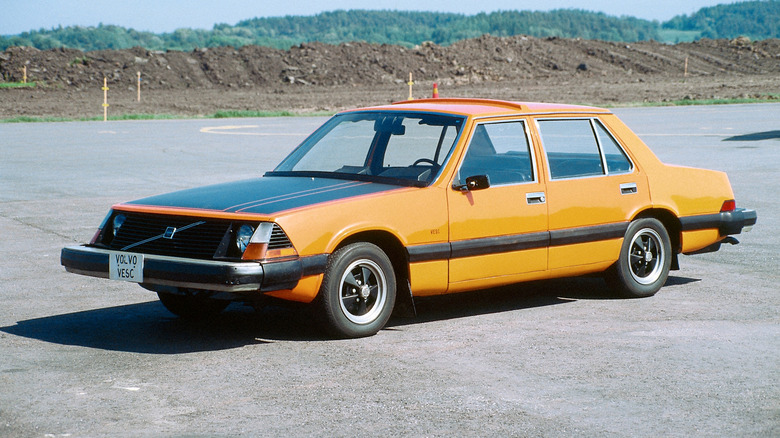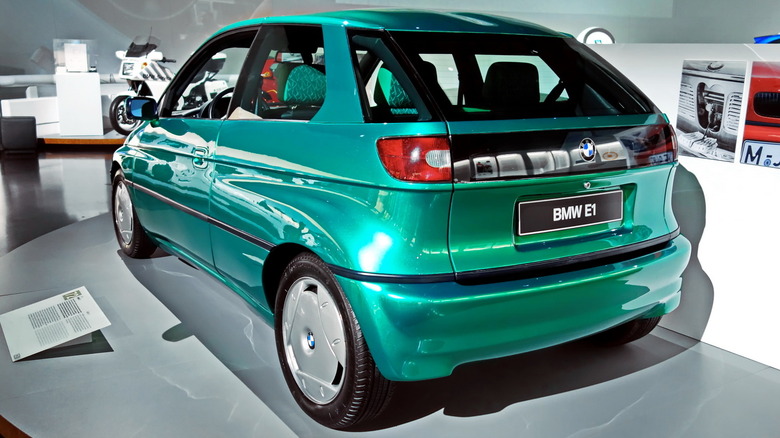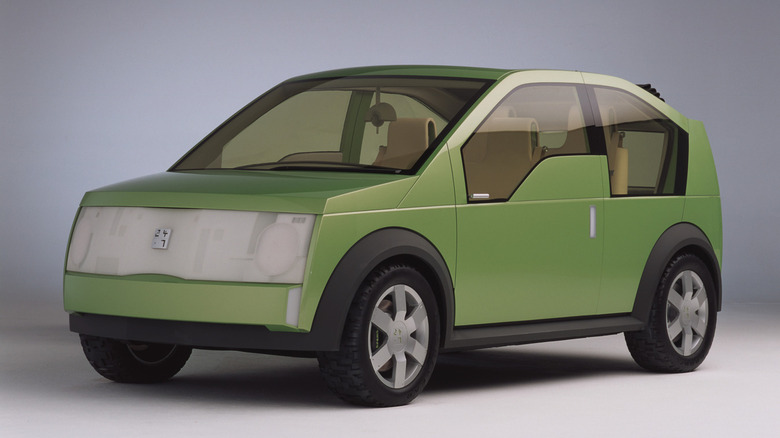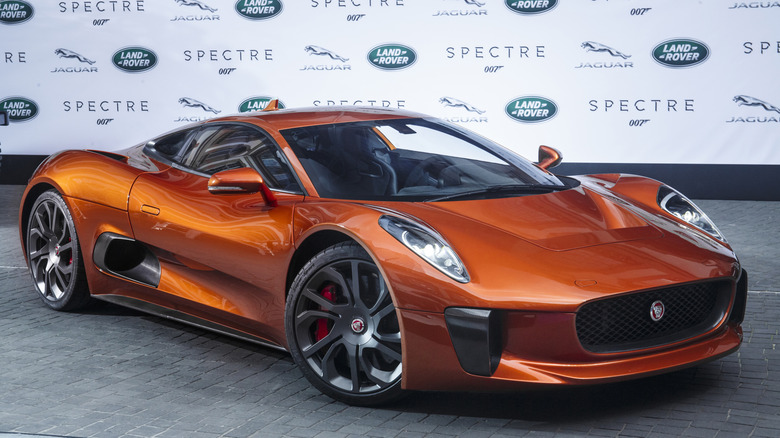10 Classic Concept Cars That Were Way Ahead Of Their Time
Concept cars bring the buzz. They wow the crowds at auto shows and send glossy car magazines flying off newsstand shelves. To a large extent, the buzz is the point. Carmakers can remind crowds that car companies are still around and are planning on bringing great stuff in the future. The word future is key here since most concept cars serve as showcases for technologies that their manufacturers are developing, new directions in style and design, or both. As such, concept cars are often intended to be way ahead of their time.
They can be a bit too futuristic, resembling iconic sci-fi vehicles from movies and TV more than realistic prototypes for upcoming models. They sport designs with impossibly low rooflines, windshields raked back at wild angles, gun slit side windows, and bodywork flush to the point where bystanders might scratch their heads and wonder where the door handles are. Many of these features are unrealistic for a production vehicle, especially one intended for mainstream motoring. They look fantastic, though, and that's the point. These concepts are designed to get attention.
Yet, a good concept car is still a preview of things to come. A carmaker might present a new design language that will eventually spread across their entire model range, even if it won't be quite as extreme as the concept. Concept cars can also display new technology that will be used in upcoming models, whether advanced safety technology or new drivetrain tech such as electric motors. A well-done concept car is a milestone in a manufacturer's history. Some concepts are so visionary that enthusiasts still marvel at them decades later.
1938 Buick Y-Job
Many consider the stunning, Art Deco-inspired Buick Y-Job to be the world's first concept car. It beat other contenders for that title, such as the plexiglass-bodied Pontiac Ghost Car displayed at the 1939 World's Fair. The Y-Job also holds another advantage over the Ghost Car. The Y-Job was a preview of Buicks to come, whereas the Ghost Car was built strictly as an attention-getting publicity exercise. GM's Art and Color department designed the Y-Job under the leadership of Harley Earl (pictured above), who would go on to become one of the most influential car designers in American history. In the case of the Y-Job, the designer, George Snyder, would transform Earl's vision for the car into design sketches.
And what a vision it was, blending flowing curves, a peaked hood, and bulging fenders that gave the impression of a jungle cat about to pounce. Horizontal chrome strakes on the lower parts of the fenders display the influence of the era's Art Deco design aesthetic. In front, the Y-Job's waterfall grille would become a Buick signature for years. A bombsight hood ornament nodded to the Y-Job's aviation influences and became a feature of production Buicks. Hidden headlights would appear on future Buick models like the late 1960s Riviera.
While the 320 cubic inch, 141-horsepower V8 under the hood was an unmodified version of contemporary Buick production engines, other features were cutting-edge, including the car's power windows and the metal deck panel that covered the convertible roof when it was retracted. The Y-Job was highly functional for a show car, and Harley Earl drove it as his personal car for years before it was retired to automotive museums. Today, many view it as one of the coolest concept cars of all time.
1955 Alfa Romeo BAT 9
The Alfa Romeo BAT was actually a series of three concept cars, with the concept reaching its fullest realization in the 1955 BAT 9 model. BAT stands for Berlina Aerodinamica Tecnica, although the acronym BAT is a happy coincidence since the BAT does resemble a bat with its wings folded back in a dive. Or perhaps it looks like a car a certain beloved superhero would drive. As its full name suggests, the BAT series served as a test bed for aerodynamic styling, seeking to transform the chunky cars of the day into sleek and fuel-efficient machines knifing their way through the air.
Alfa Romeo engaged the design house of Carrozzeria Bertone to design the BAT cars. Bertone used a production Alfa chassis from the 1900 Sprint and standard engines from Alfa's existing models. The goal was to find out how much an aerodynamic body could contribute to speed, stability, and fuel efficiency, even if everything under the skin was a bog-standard production car. The first few BATs never left the design studio, but the 1953 BAT 5, the 1954 BAT 7, and the 1955 BAT 9 were all fully drivable cars.
In addition to the functional curled tailfins, design elements like hidden headlights and partially covered wheel wells helped improve aerodynamics. The BAT series reached a jaw-dropping coefficient of drag (Cd) of 0.19. Modern cars wouldn't reach similar Cd numbers until quite recently, aided by the use of powerful computers that Alfa's designers could only have dreamed of. This makes their accomplishment all the more astounding.
1959 Corvette Stingray
The term Stingray has been associated with the Corvette for so long that many people probably don't realize that Chevrolet didn't start using the Stingray name until several years after the Corvette was introduced. While the first production Stingray was the classic and much-revered 1963 Corvette Sting Ray (later contracted to the more zoologically correct Stingray), the name first appeared on a concept car that became a classic in its own right, the 1959 Chevrolet Stingray. This car, which was both a functional race car and a concept car, was based on the 1957 Corvette SS race car, which was also the first Chevrolet model to wear the SS badge.
The '59 Stingray was a beast for its era, with its 315 horsepower 283 small block V8 pushing only 2,200 pounds of car. This was about 700 pounds less than a road-going Corvette and reflected how thoroughly the Stingray had been bred for racing. The Stingray was a collaboration between the famous trio of Bill Mitchell (GM's director of styling), Peter Brock, and Larry Shinoda, three names still fondly recalled by Corvette enthusiasts. The Stingray's Italian-inspired looks strongly hinted at the design direction of the production Corvette Sting Ray that would debut four years later. In a further nod to European sports car influence, it rode on a chassis borrowed from a Mercedes-Benz 300SL.
Its racing career was successful but short. It finished fourth in its first race in 1959 and then won the 1960 SCCA national championship. Having demonstrated the viability of a Corvette racer, it was retired from racing without ever being taken to Europe to race against its inspirations. It became a concept that Bill Mitchell drove on weekends, now equipped with a 327 V8.
1969 GM XP-883
The GM XP-883 never set pulses racing like the Corvette Stingray, but it heralded a category of vehicle that would become popular almost a half-century later in plug-in hybrid gas-electric cars. One could argue that this makes it one of the most far-seeing concept cars of all time. It wasn't a bad-looking little car, either, with a front end that resembled a Studebaker Avanti and a big-windowed, pillarless hatchback profile that could even be called cute, especially in the concept car's fire-engine red paint job. Like the Avanti, it features a fiberglass body for weight savings.
Of course, looks weren't the XP-883's reason for existence. That lay under its lightweight skin in a hybrid drivetrain very similar to modern-day hybrids like the new Toyota Prius plug-in. It got its pep, such as there was, from a 35 cubic inch two-cylinder engine paired with a DC motor. The latter drew power from six standard lead-acid automotive batteries that could be plugged into a 115-volt electric outlet to charge. The batteries were housed under the cargo area and could also recharge during driving via a flywheel alternator.
Except for having lead-acid batteries instead of the long-lasting lithium-ion hybrid batteries in modern hybrids, this is the basic configuration of most plug-in hybrid cars today. Performance wasn't the XP-883's strong suit, as it required 28 seconds to reach 60 mph — which was also its top speed. Still, as a premonition of things to come, it was far ahead of its time.
1972 Volvo VESC
The Volvo VESC is arguably the un-sexiest concept car on this list, but it's also possibly one of the most important in terms of previewing safety technologies that would become standard equipment on most cars decades later. It had a face that only its designers could love, and even its designers probably preferred not to look at it for too long. All the boxy lines and right angles that you would expect from a 1970s Volvo sedan are there (it hinted at the 1974 Volvo 240's design), but it sports an oddly sloping grille with an almost comically extended bumper protruding in front of it. The rear bumper was also fairly prominent but not nearly as visually jarring as the one in front.
But these bumpers were functional as they protected the car from any damage at speeds up to 10 mph. This was only one of numerous safety technologies built into the VESC. These included airbags and a steering wheel that retracted away from the driver in a crash. Semi-passive seat belts strapped in the car's occupants when the motor was running. Wipers kept the rear windows and headlights clean. The body was reinforced to absorb impacts, rollovers, and side collisions. The engine was designed to slide under the passenger compartment in a crash. The car even had anti-lock brakes.
Many of these innovations were integrated into the Volvo 240, helping to create Volvo's legendary reputation for safety. Volvo later invented many other common safety features found in today's cars. The VESC also addressed environmental concerns with exhaust gas recirculation and innovative catalytic converter technology.
1991 BMW E1
Oh, so close. BMW almost beat all other mainstream manufacturers to market with an electric vehicle (EV), but ultimately, the 1991 BMW E1 ended up being relegated to the history books. It became a BMW EV that you couldn't buy, and one wonders what could have been had the first EV been sold by the manufacturer known for building the ultimate driving machine. EVs could have become cool way back when the first George Bush was president.
Actually, the E1 wouldn't have set any performance records. It sported a 19.2 kWh battery pack, compared with the 40 kWh base battery in the 2025 Nissan Leaf, one of the least powerful EVs on the market. It's far short of the 84 kWh battery capacity of the i4, BMW's least expensive EV that's for sale today. The base i4's 335 horsepower would completely obliterate the E1's 45 horses.
Still, for its time period, the E1 was a huge step forward for electric cars, although it was primarily intended as an engineering exercise. The real goal was to get its electric tech into the 3 Series, with the ultimate aim of selling as many as 40,000 electrified 3 Series per year. So what happened? The E1 ran into an issue that still plagues EVs today. Electric vehicles tend to catch fire at relatively high rates. After a fire destroyed the E1 prototype and damaged an adjacent building, BMW abandoned the pursuit of a production EV for almost two more decades.
1997 AC Propulsion tZero
Both AC Propulsion and its tZero fully electric sports car may inspire head-scratching among even the most dedicated gearheads, but it helped shape EV history by inspiring the creation of Tesla Motors. The tZero's production run consisted of exactly three vehicles, making them basically concept cars intended to demonstrate the viability of an electric sports car. The tZero prototypes also demonstrated AC Propulsion's EV capabilities to other carmakers who might want to partner with them to create electrified vehicles under contract. Over the years, the company worked with Mini and General Motors, among others.
AC Propulsion was founded by Alan Cocconi. His partner, Tom Gage, would eventually become the company's CEO. The first iteration of their own home-grown tZero sported lead-acid batteries producing 201 horsepower. With this hardware installed in a lightweight kit car body, the tZero was seriously quick, hitting 60 mph in only 3.6 seconds. It also offered a driving range of 300 miles between charges, which was sensational at the time. Eventually, a man named Martin Eberhard commissioned a tZero to be built with new lithium-ion battery technology.
He loved it and wanted to finance a production run. When AC Propulsion refused Eberhard's offer to put the tZero into production, he approached other investors. One of them was Elon Musk. Together, Eberhard and Musk co-founded Tesla Motors. Tesla's iconic first car, the Tesla Roadster, used AC Propulsion's electric drivetrain in the body of a Lotus Elise. Eventually, Tesla developed its own drivetrain, and the rest is automotive history.
2000 Ford 24.7
Connectivity features like Apple CarPlay and Android Auto are standard even in base model economy cars today, but a quarter century ago, they were almost unheard of until Ford created a rolling technology showcase called the 24.7. Unveiled at the 2000 North American Auto Show, the 24.7's appliance-like exterior appearance highlighted the fact that its most important technology was in the passenger compartment. The 24.7 came in three models: a wagon, a truck, and a coupe. All three featured the same boxy design style that would be right at home in Minecraft.
The inside was almost more Spartan than the outside, with seats that seemed to hover in mid-air with no regard for features like seatbelts. Instead, all attention was focused on the blue LED screen stretching across the entire dashboard. This screen offered full-service information delivery, complete with prompts for video and phone calls, a camera, emails, and more. Occupants could even send an eFax!
Keep in mind that 24.7 premiered seven years before Steve Jobs and the iPhone changed everything. So, 24.7 failed to anticipate that many of its functions would be absorbed into a single device that would sync with our cars as soon as we got in them. But it did anticipate a world where our home, work, and social lives would follow us everywhere we went in our cars, for better or worse.
2004 Ford Bronco
The 21st century has seen a number of retro-designed SUVs hit the market, a trend foreshadowed by the 2004 Ford Bronco concept. Indeed, the present-day Bronco carries hints of the concept's design in its aggressive, off-road-focused stance, prominent fender flares, and squared-off body style. Similar retro-future SUV styling cues can be seen in other current models, such as the 2024 Toyota Land Cruiser. The Bronco concept blazed that trail 20 years earlier.
The concept Bronco was built on an Escape crossover chassis and featured a 2.0-liter turbodiesel engine. It delivered 128 horsepower and 244 lb-ft of torque through an advanced all-wheel-drive system that intelligently distributed power. Usually operating in front-wheel drive mode, the system would engage the rear wheels when needed. The concept's design was ideal for an off-roader, with a short wheelbase, massive wheel arches, and a two-door cabin. Signature elements like exposed door hinges, circular headlights, and a prominent winch under the grille also captured the essence of off-roading, marking a notable departure from other SUVs of the era.
The interior is plain but finished in high-end materials, and the roof is removable, just like the contemporary production Bronco. The modern Bronco has removable doors, too, for truly open-air motoring in the vein of its chief rival, the Jeep Wrangler. The 2004 concept hinted at the Ford Bronco vs. Jeep Wrangler competition of the 2020s.
2010 Jaguar C-X75
The forerunner of the hybrid supercar genre was the 2010 Jaguar C-X75 concept. In recent years, supercar engineers have embraced hybrid gas-electric powertrains for their ability to deliver extra horsepower and torque beyond what gasoline engines alone can deliver. Electric motors positioned at the front wheels or all four wheels can give many modern supercars all-wheel drive for extra grip in the corners and faster launches, as was true of the C-X75. Today, it's not unusual to hear of supercars with top speeds approaching or even exceeding 250 mph. The C-X75 wasn't quite that fast, topping out at an estimated 220 mph, but it blazed the trail.
Specs vary depending on the source, but according to Car and Driver, the C-X75's powertrain features a turbocharged and supercharged, 16-valve, DOHC, 1.6-liter four-cylinder gasoline engine paired with two AC synchronous electric motors. The small combustion engine generates a rather surprising 502 horsepower, while each electric motor contributes up to 195 horsepower. This powertrain produces a combined total of 890 horsepower and 738 lb-ft of torque. The electric motors are powered by a 19-kWh lithium-ion battery pack. Fully unleashed, this hybrid beast could race from zero to 60 mph in only 3.3 seconds.
Jaguar only built five C-X75 prototypes for testing on tracks and runways. Reviewers didn't get to drive them on the road, but an Autoweek reviewer noted that fit and finish are good for a concept car, and it's surprisingly easy to see out the windows. Ultimately, though, the C-X75 was a technology demonstration rather than a prototype for a production car. Yet, it pointed the way to today's hybrid supercars.
